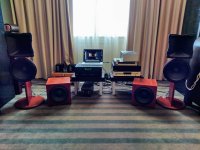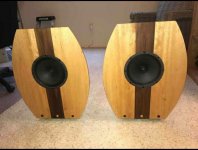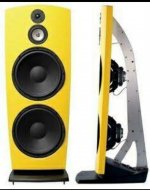Hi all,
Please see the attached images.
Some DIY open baffles have large (in terms of width) baffles, but some people are able to manage with smallest baffle width possible.
When i say small, i mean relative to the size of the driver.
How are they able to manage with smallest baffle size (in terms of width) ?? For example, for a 15" driver, how to manage with a baffle width of 17 to 18"
One of the important functions of the baffle is to separate the rear waves and front waves. In that sense, large baffle if preferred. But with small baffles, how is the front and rear waves separation possible ??
And then there is another concept of acoustic off center to reduce the peaks, which is obviously not possible with baffles with small width.
Please see the attached images.
Some DIY open baffles have large (in terms of width) baffles, but some people are able to manage with smallest baffle width possible.
When i say small, i mean relative to the size of the driver.
How are they able to manage with smallest baffle size (in terms of width) ?? For example, for a 15" driver, how to manage with a baffle width of 17 to 18"
One of the important functions of the baffle is to separate the rear waves and front waves. In that sense, large baffle if preferred. But with small baffles, how is the front and rear waves separation possible ??
And then there is another concept of acoustic off center to reduce the peaks, which is obviously not possible with baffles with small width.
Attachments
Last edited:
You can make them as small as you wish, even using the bare speaker hanging from a wire ... just don´t expect much Bass ... if any at all.
"In the old days" , many manufacturers showed frequency response of the raw driver, mounted on a pole or something, no Baffle at all.
Only later the standard IEC baffle was introduced (and probably an earlier DIN version)
"In the old days" , many manufacturers showed frequency response of the raw driver, mounted on a pole or something, no Baffle at all.
Only later the standard IEC baffle was introduced (and probably an earlier DIN version)
That's interesting....You can make them as small as you wish, even using the bare speaker hanging from a wire ... just don´t expect much Bass ... if any at all.
"In the old days" , many manufacturers showed frequency response of the raw driver, mounted on a pole or something, no Baffle at all.
Only later the standard IEC baffle was introduced (and probably an earlier DIN version)
If we use separate subs for bass, we can use smaller baffles.
But what about cancellation of front and rear waves ??
Having a baffle or frame at low frequencies makes things simpler and there is no real advantage to baffleless, however above bass frequencies there are real advantages to having no baffle. In Pursuit of a 20-20k Dipole Loudspeaker
Have a look at the archived info on the Nao Note RS II open baffle speaker. This is a minimal baffle speaker with a 2x10" woofer section in a Z configuration.
Original Offerings
This design with a DSP based crossover and I suspect other equalisation to maintain bass performance. This is one way of doing it.
Original Offerings
This design with a DSP based crossover and I suspect other equalisation to maintain bass performance. This is one way of doing it.
Yes, we need lots of equalization and gain matching, dsp is only reasonable choice nowdays. The challenge is to get smooth response without excessive distortion. This tends to mean a 4-way speaker.

Radiation pattern and dipole cancellation depend on frequency/wavelength
Please study basics here
Tech
Dipolplus - Alles über offene Schallwände (a summary in English Dipolplus - Alles über offene Schallwände )
Electro-acoustic models

Radiation pattern and dipole cancellation depend on frequency/wavelength
Please study basics here
Tech
Dipolplus - Alles über offene Schallwände (a summary in English Dipolplus - Alles über offene Schallwände )
Electro-acoustic models
Last edited:
Thank you so much guys ....
Let's forget about highs and mids.
If we talk about OB bass, the wavelength of 150Hz is 7.5ft.
Frequencies lower than 150Hz have even bigger wavelengths.
So for OB bass drivers (let's say 15" drivers), even if we make the baffle 2 or 3 ft wide, still there is now way we can separate the front and rear low frequency waves.
Because all those wavelengths are above 7ft.
Let's forget about highs and mids.
If we talk about OB bass, the wavelength of 150Hz is 7.5ft.
Frequencies lower than 150Hz have even bigger wavelengths.
So for OB bass drivers (let's say 15" drivers), even if we make the baffle 2 or 3 ft wide, still there is now way we can separate the front and rear low frequency waves.
Because all those wavelengths are above 7ft.
too much reading will confuse you more, trust me
get any big size woofer and try listening it on nude or no baffle. if you don't like it then go back to boxed bass, if you like it then make experiment of your desired baffle size. this is DIY anyway, you'll start getting the sense of OB bass. giving baffle with different shape will give different result.
get any big size woofer and try listening it on nude or no baffle. if you don't like it then go back to boxed bass, if you like it then make experiment of your desired baffle size. this is DIY anyway, you'll start getting the sense of OB bass. giving baffle with different shape will give different result.
This is definitely a good practical approach worth trying. Thanks a lot !!!too much reading will confuse you more, trust me
get any big size woofer and try listening it on nude or no baffle. if you don't like it then go back to boxed bass, if you like it then make experiment of your desired baffle size. this is DIY anyway, you'll start getting the sense of OB bass. giving baffle with different shape will give different result.
There is no way to answer your question as stated. You need to know and state what your performance requirements are below about 300 Hz. How loud do you need to play from a pair. How low do you need to go at the selected loudness. What true minimum efficiency you require.
You can buy 12 each (6 each per stereo channel) 10" high Q, medium excursion drivers for as little as $20 each and make a shallow 10" front to back by 11" wide Open Baffle that can actually deliver solid bass into the low 30's. Yes it will be a tall speaker at 65" or so, but as narrow as many box speakers that can't come close in terms of bass extension and clarity. As always, it is about defining goals and engineering.
You can buy 12 each (6 each per stereo channel) 10" high Q, medium excursion drivers for as little as $20 each and make a shallow 10" front to back by 11" wide Open Baffle that can actually deliver solid bass into the low 30's. Yes it will be a tall speaker at 65" or so, but as narrow as many box speakers that can't come close in terms of bass extension and clarity. As always, it is about defining goals and engineering.
too much reading will confuse you more, trust me
get any big size woofer and try listening it on nude or no baffle.
Then there really will be no bass
That's interesting.... Please let me know if i understood correctly. So basically it is like a mini line array, with the rear side of the box open. Right ??There is no way to answer your question as stated. You need to know and state what your performance requirements are below about 300 Hz. How loud do you need to play from a pair. How low do you need to go at the selected loudness. What true minimum efficiency you require.
You can buy 12 each (6 each per stereo channel) 10" high Q, medium excursion drivers for as little as $20 each and make a shallow 10" front to back by 11" wide Open Baffle that can actually deliver solid bass into the low 30's. Yes it will be a tall speaker at 65" or so, but as narrow as many box speakers that can't come close in terms of bass extension and clarity. As always, it is about defining goals and engineering.
Try this Gainphile: Dipole Bass Array.
Four 10" drivers per side will give you greater than 15" driver surface area.
Four 10" drivers per side will give you greater than 15" driver surface area.
I made a ripple with dual 15" drivers placed opposite to each other.... Somehow I didn't succeed in getting satisfactory bass. I followed online articles to estimate the volumes of front and rear chambers, and crosssections of openings. Somehow it was a failed attempt to build a ripple for me.The smallest "baffle" for a woofer is probably a "Ripole"
Did you reverse electrical phase on one driver or not?I made a ripple with dual 15" drivers placed opposite to each other.... Somehow I didn't succeed in getting satisfactory bass. I followed online articles to estimate the volumes of front and rear chambers, and crosssections of openings. Somehow it was a failed attempt to build a ripple for me.
You should look through the gainphile site that is linked to in post 15. You should also look at linkwitzlab.com. It is huge and much of it is technical, but it is one of the best source of info on dipoles.
As you might be noticing just from the replies to your question, there are many different ways of dealing with the bass issue in dipoles and there is a huge volume of discussion on the web about this. Designers use EQ, arrays, wide baffles, hybrids and other approaches. You would probably be helped by reading about the development process of a single speaker. Linkwitz documented the evolution of his flagship dipole speaker in great detail. Experimenting blindly might teach you a little but at some point if you really want to understand you are going to have to read the theory.
You would also learn a lot by building a preexisting dipole. Here is one with a small baffle:
Gainphile: S20-Z Compact Open Baffle using Zaph Kit
As you might be noticing just from the replies to your question, there are many different ways of dealing with the bass issue in dipoles and there is a huge volume of discussion on the web about this. Designers use EQ, arrays, wide baffles, hybrids and other approaches. You would probably be helped by reading about the development process of a single speaker. Linkwitz documented the evolution of his flagship dipole speaker in great detail. Experimenting blindly might teach you a little but at some point if you really want to understand you are going to have to read the theory.
You would also learn a lot by building a preexisting dipole. Here is one with a small baffle:
Gainphile: S20-Z Compact Open Baffle using Zaph Kit
Dipoles with narrow baffles seems to be extremely difficult to equalize and extremely sensible to room placement.
These are my speakers on audio show in Warsaw. There were four set of speakers in our DIY room. My baffle-less speakers were the most difficult to place. Moving nearby objects even a little bit changed behavior of midbass frequencies. Bass-reflex loudspeakers were much more forgiving.
Nearfield equalization doesn't work for baffle-less drivers. If baffle-less driver is equalized near field, the equalization is completely useless from listening position in my room. Don't be fooled by pretty "8" directivity of dipoles. They actually exhibit a flower like behavior with many-many petals.
On the plus side, imaging is really good. Speakers completely disappear. In my speakers horn section is vibroisolated from the midbass and doesn't move when playing.
These are my speakers on audio show in Warsaw. There were four set of speakers in our DIY room. My baffle-less speakers were the most difficult to place. Moving nearby objects even a little bit changed behavior of midbass frequencies. Bass-reflex loudspeakers were much more forgiving.
Nearfield equalization doesn't work for baffle-less drivers. If baffle-less driver is equalized near field, the equalization is completely useless from listening position in my room. Don't be fooled by pretty "8" directivity of dipoles. They actually exhibit a flower like behavior with many-many petals.
On the plus side, imaging is really good. Speakers completely disappear. In my speakers horn section is vibroisolated from the midbass and doesn't move when playing.

Yes....tried both options. With one phase there is zero bass. With reverse phase, there is bass. But nothing unique and spl is also not upto expectations. Then I built two individual H frames with those two drivers, and it was lot better than ripple.Did you reverse electrical phase on one driver or not?
As far as the physical construction of ripple is concerned, I did it reasonably good based on many online articles. Somehow didn't work as expected.
- Home
- Loudspeakers
- Multi-Way
- How to design open baffles with smallest possible baffle size

